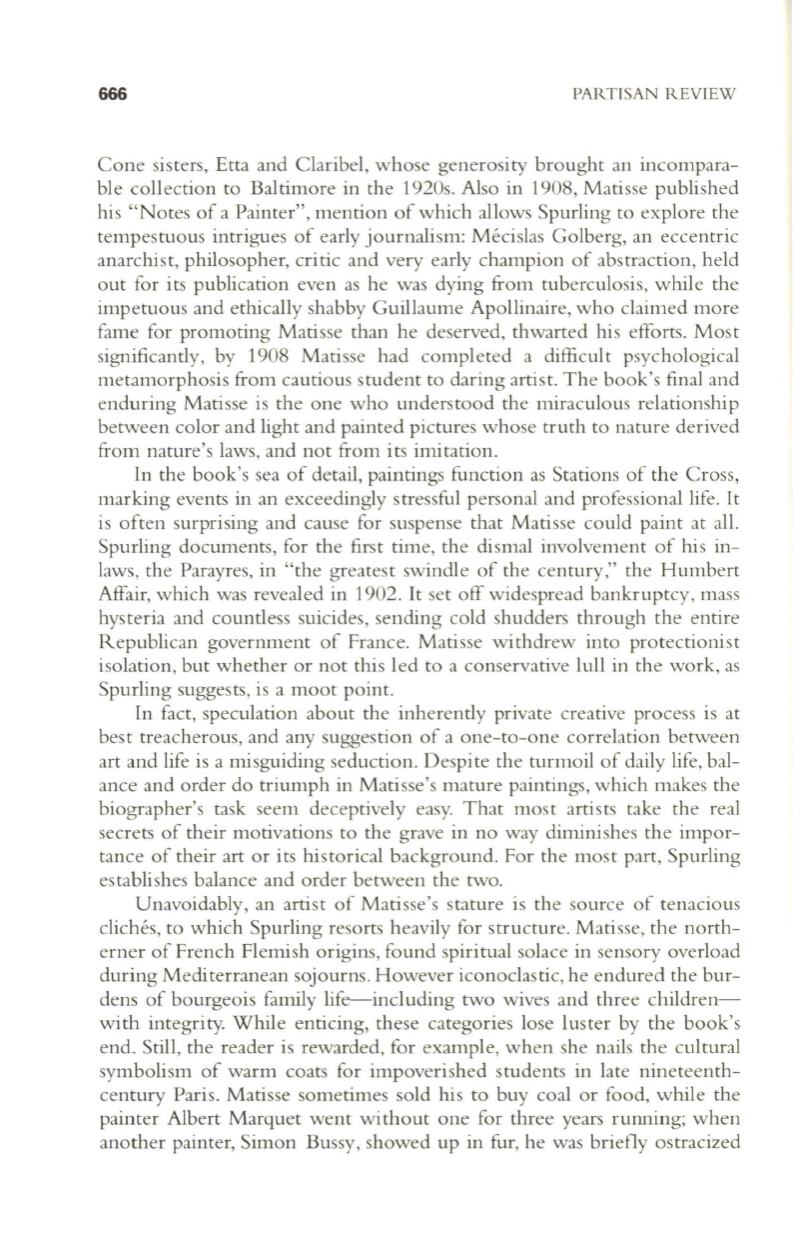
666
PARTISAN REVIEW
Cone sisters, Etta and Claribel, whose generosity brought an incompara–
ble coll ection to Baltimore in the 1920s. Also in 1908, Matisse published
his "Notes of a Painter", mention of which allows Spurling
to
explore the
tempestuous intrigues of early journalism: Mecislas Golberg, an eccentric
anarchist, philosopher, critic and very early champion of abstraction, held
out for its publication even as he was dying from tuberculosis, while the
impetuous and ethically shabby Guil laume Apollinaire, who claimed more
fame for promoting Matisse than he deserved, thwarted his efforts. Most
significantly, by 1908 Matisse had completed a difficult psychological
metamorphosis from cautious student to daring artist. The book's final and
enduring Matisse is the one who understood the miraculous relationship
between color and light and painted pictures whose truth to nature derived
from nature's laws, and not from its imi tation.
In the book's sea of detail, paintings function as Stations of the Cross,
marking events in an exceedingly stressful personal and professional life. It
is often surprising and cause for suspense that Matisse could paint at all.
Spurling documents, for the first time, the dismal involvement of his in–
laws, the Parayres, in "the greatest swindle of the century," the Humbert
Affair, which was revealed in 1902. It set off widespread bankruptcy, mass
hysteria and countless suicides, sending cold shudders through the entire
Republican government of France. Matisse withdrew into protectionist
isolation, but whether or not this led to a conservative lull in the work, as
Spurling suggests, is a moot point.
In fact, speculation about the inherently private creative process is at
best treacherous, and any suggestion of a one-to-one correlation between
art and life is a misguiding seduction. Despite the turmoil of daily life, bal–
ance and order do triumph in Matisse's mature paintings, which makes the
biographer's task seem deceptively easy. That most artists take the real
secrets of their motivations to the grave in no way diminishes the impor–
tance of their art or its historical background. For the most part, Spurling
establi shes balance and order between the two.
Unavoidably, an artist of Matisse's stature is the source of tenacious
cliches,
to
which Spurling resorts heavily for structure. Matisse, the north–
erner of French Flemish origins, found spiritual solace in sensory overload
during Mediterranean sojourns. However iconoclastic, he endured the bur–
dens of bourgeois family life-including two wives and three children–
with integrity. While enticing, these categories
10
e luster by the book's
end. Still, the reader is rewarded, for example, when she nails the cultural
symbolism of warm coats for impoverished students in late nineteenth–
century Paris. Matisse sometimes sold his to buy coal or food, while the
painter Albert Marquet went without one for three years running; when
another painter, Simon Bussy, showed up in fur, he was briefly ostracized


